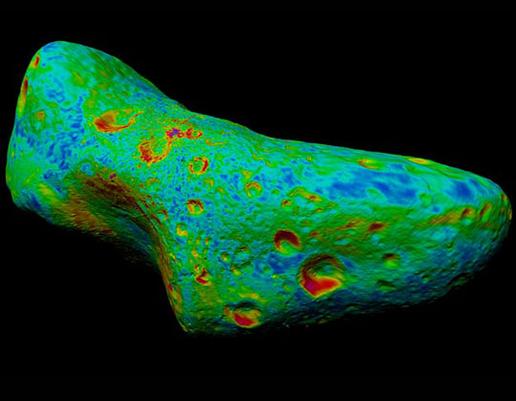
© NASA/Goddard
Earth's gravity may not have the gravitas of Jupiter, but the planet regularly plucks small asteroids passing by and pins them into orbit. The mini-moons don't stay for long. Within a year or so they resume their looping, twisting paths like crazy straws around the sun. But others arrive to take their place.
Simulations show that two asteroids the size of dishwashers and a dozen half-meter (1.6 feet) in diameter are orbiting Earth at any given time. Every 50 years or so something the size of a dump truck arrives. So far, there's been just one confirmed sighting.
"We'd eventually like to see a mission to a mini-moon," astronomer Robert Jedicke, with the University of Hawaii, said this week at a workshop in Huntsville, Ala., to discuss proposals for two spare Hubble-class spy telescopes donated to NASA by the National Reconnaissance Office.
Jedicke would like to use one of the telescopes to hunt for near-Earth objects, including mini-moons, which could be captured whole and brought to the ground for study.
"It's the Rosetta stone of the solar system. You bring back a chunk of material that's never been processed through the atmosphere, that's not been sitting on the ground. It's going to be a tremendous wealth of information about how the solar system formed -- even more so if you can bring back more than one and get different types of material," Jedicke told Discovery News.
"The great thing is you don't have to go very far," he added. "These things are sitting there right in geocentric orbit and they're relatively easy to get to."
But hard to find.
A paper published last year showed that, in theory, a cloud of temporarily captured asteroids circles Earth at all times, but that the largest object is just about a meter (3 feet) in diameter.
"These are really difficult to detect with current technology," said astronomer Paul Chodas, with NASA's Near Earth Object program at the Jet Propulsion Laboratory in Pasadena, Calif.
So far, the only confirmed captured asteroid that orbited Earth was RH120, which most recently visited from September 2006 to June 2007. Initially, the object was suspected of being a spent upper-stage motor from an Apollo rocket, but follow-up observations by ground-based radars determined the object was not metallic.
"There is great interest in tracking these Temporarily Captured Objects (TCOs), because for a short time they are easily accessible for both scientific study and, possibly, eventually, resource utilization," Chodas wrote in an email to Discovery News.
In addition to being small, mini-moons are difficult to find because they only hang around for a relatively short time, between six and 18 months.
"We would want to discover one of these as soon after capture (by Earth's gravity) as possible to have enough time to get a spacecraft out there, and then still have time to study the object before it escapes back into heliocentric orbit," Chodas said.
In addition to science, there is economic interest in asteroids. Two U.S. firms, Planetary Resources and Deep Space Industries, announced plans last year to mine asteroids for raw materials. Both companies are developing precursor missions to scout potential targets.
"Maybe you're not going to mine a half-meter diameter wide asteroid, but you can test out your techniques on it," Jedicke said.
Hunting mini-moons wouldn't be the telescope's only job.
"It would be best asteroid survey ever of the entire solar system," Jedicke said.
"That survey could be used to build up a very deep image of the sky in that region which could be used to look for supernova, gamma ray bursts, asteroid collisions -- basically anything that changes, this survey would find," he said.
A list of proposals for the donated telescopes is expected to be presented to NASA managers next week.
we have plenty death stars in the orbiting alrerady yes?